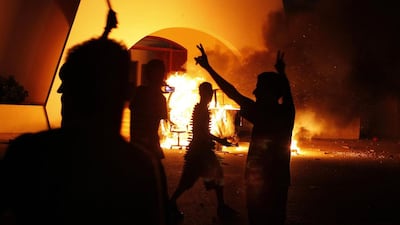Ansar Al Sharia, one of Libya’s foremost extremist groups, is disbanding after suffering heavy losses in its main base of Benghazi.
The collapse of the group is a victory for the Libya National Army (LNA) led by Field Marshal Khalifa Haftar, who launched an operation in May 2014 to crush radical militias in the eastern city.
Ansar Al Sharia’s leadership announced its “dissolution” in a communique released online on Saturday, saying the decision was taken because it had been “weakened” by the fighting in Benghazi.
The group, linked to Al Qaeda, has been designated a terrorist organisation by the UAE, United Nations and United States. It sprang to infamy in September 2012, when Washington accused it of killing ambassador Chris Stevens and three staff in an attack that month on the American consulate in Benghazi.
Ansar Al Sharia shares a name – which translates from Arabic as “Partisans of Islamic law” – with other radical groups in Tunisia and Yemen. These groups have no formal affiliation, but share similar aims. The Libyan Ansar Al Sharia officially formed in June 2012 and was once one of the most powerful militant groups in Libya, with an estimated strength of up to 5,000 fighters that year.
The group rejected successive governments set up in Libya following the overthrow of Muammar Qaddafi in 2011, insisting that only its leaders were qualified to command the country.
At its zenith, Ansar Al Sharia was present in Benghazi and Derna in eastern Libya, with offshoots in Sirte and Sabratha in the west of the country. In Benghazi, its checkpoints, flying black flags displaying two crossed Kalashnikov machine guns, covered many sections of the city in 2012 and its units guarded the main hospital.
The group’s Benghazi headquarters was burnt down by mobs in a popular backlash following the US consulate attack. But by March 2013 the militants were back in the city, raiding schools to ensure that children were taught from books the group approved of.
Ansar Al Sharia has suffered a number of body blows since then.
After three years of fighting Field Marshal Haftar’s forces, with thousands of deaths on both sides and the devastation of Benghazi’s historic centre, Ansar Al Sharia and allied radical militias, including ISIL, are now trapped in two small enclaves near the city’s port.
The group’s leader, Mohammed Azawi, was killed battling the LNA in Benghazi at the end of 2014 and it has never announced his successor.
Ansar Al Sharia has also seen its fighters defect to ISIL in large numbers since 2014, effectively dissolving its units in Derna, Sabratha and Sirte.
Another setback for the group is the trial in Washington this September of one of its former leaders, Ahmed Abu Khattala, over the attack on the US consulate in Benghazi. The trial is likely to highlight the names of the group’s wider membership and possibly expose its finances and personnel to global scrutiny.
Abu Khattala was arrested in a snatch operation from Benghazi by US special forces in June 2014. He has failed with a number of pretrial motions to restrict the trial or win back his freedom.
But perhaps the biggest problem of all has been that Libya is a tribal-based society and, like ISIL, Ansar Al Sharia has failed to win mass support among ordinary Libyans for its hardline doctrines.
foreign.desk@thenational.ae

